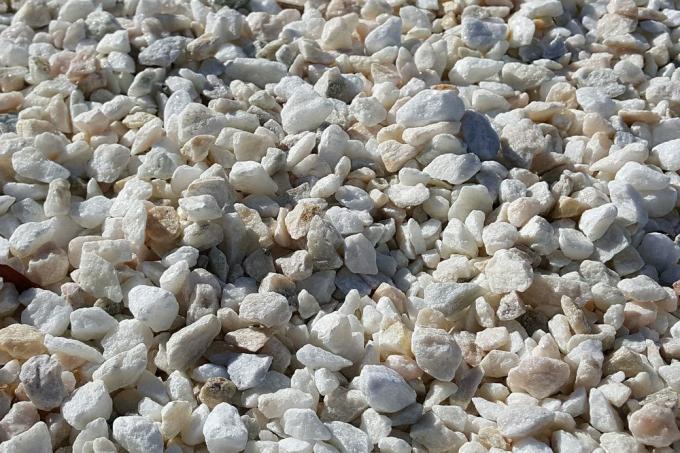
table of contents
- Suitable stones
- Grave design with gravel: 5 ideas
- Different stone shapes: use: 5 ideas
- frequently asked Questions
The grave design with stones can be realized in a decorative way individually and apart from traditional forms. In this guide you will find 10 ideas for easy-care and long-lasting design of the final resting place.
In a nutshell
- Natural stones are the ideal material for the design of graves
- They are used in various forms, for example as decorative gravel or whole stones
- The colors and shapes of the natural stones are decisive for the final design concept
- There are different styles available for design
Suitable stones
If you want to make the grave of a deceased easy to care for and durable, you should rely on natural stones. These have the best properties for extensive use over many years and fit harmoniously into the image of the cemetery. The following types have become established:

- quartz
- basalt
- granite
- Slate (Bordeaux)
- Field stones
- Boulders
The stones are available in the following forms, which has a significant impact on costs:
- gravel
- Grit
- blocks
- natural stones
- Stone figures
- elaborately shaped pieces by the stonemason
The large number of available colors makes it possible to adapt the grave design to the tombstone. This is an important factor: Always choose the stones for the decor that match the tombstone, the desired planting and the motifs that should embody the deceased.
Tip: Do not use white marble for the design, because the surface is a real sponge for dirt. If you want to use marble, you should use figures made from the stone (e.g. Angel) fall back.
Grave design with gravel: 5 ideas
Classic gravel bed: If you want the grave to be easy to maintain and durable, a gravel bed in the desired color is recommended. It is simple, does not require a lot of maintenance and can be furnished with figures or planters. The maintenance of the gravel surface is quite easy if you have laid out a film beforehand that weeds cannot penetrate. With little effort, the grave can be attractively designed with a gravel surface.

Gravel path with plants: Another variant of the gravel surface is a path that runs straight or twisted from the end of the grave to the tombstone, as desired. This should be bordered so that suitable plants can be planted in the free areas without any problems. Rely on ground cover such as the lesser periwinkle (Vinca minor), ivy (Hedera helix), or heather (Erica) to shape the path. Even field stones can be used.
Nicely separated: In contrast to a complete area, with this idea you switch between gravel and planted areas. Orientate yourself on geometric shapes such as triangles, trapezoids or rectangles, which provide a modern touch. For example, you can fill a third with gravel or chippings, decorate one with flat ground cover, and reposition the last third with gravel or chippings.
Castle garden: If you put a flowering plant in the middle of the grave and also give all four corners green, you can conjure up a tiny castle garden. To do this, fill gravel high enough around the plant in the middle. Since the corners are also intended for plants, but not the edges, the gravel looks like a path from four directions.
Asian flair: An Asian-themed grave design with gravel can be implemented without any problems. First create elements such as boulders and individual, small plants with a lot of green such as a teddy tree of life (Thuja occidentalis 'Teddy'). Don't use too many of these and stagger them from one another. Then the gravel is poured in and straight in one direction to create a flowing movement in the gravel. Use Japanese gardens as a guide for this idea.
Note: Depending on the design idea, you should think about using a grave border. For gravel, for example, an enclosure is recommended, while this can be dispensed with when using individual stones.
Different stone shapes: use: 5 ideas
Close to nature grave: A natural grave design is the best way to use stones made of granite or other materials completely. Use Ground cover, Herbs such as thyme (thymus) and ornamental grasses that sit almost "randomly" between the stones. The effort is limited if you don't miss a regular cut.

Path slabs: Pavement slabs made of natural stone are an absolute classic. These can either be laid directly on the ground or lawn and are sufficient in combination with two plants. Lay out the path according to your preferences. Do not use hedges as edging, the cutting effort in this size is enormous.
Grave light in focus: If you want to make the grave simple, but with a touch of melancholy, rely on grave lights and stones. Focus on a luminaire that you place either in the middle or in one of the corners. Use a small stone platform to make the light even clearer. Field stones can also be used for this.
Decorative steps: If you want to use stone blocks, you can create several levels such as steps. To do this, create frames from the blocks that you fill with and provide space for a plant, lawn or gravel. You can use as many steps as you want, but don't clutter the grave. Two to three are enough.
Stone buckets in different shapes: The use of a stone bucket is just as easy to care for as the other ideas. This can be shaped according to your wishes from a wire mesh that is filled with stones. For example, if you have shaped a heart or a simple square, it can be filled with stones and used immediately.
frequently asked Questions
If you want to create a grave that is easy to care for without loose stones, you should use a grave slab. This takes up the entire grave and can even serve as a tombstone. Although the acquisition costs are significantly higher and the embedding requires a specialist, the plate can then be decorated with cut flowers, pictures and other decorations.
Yes. You must observe the current cemetery regulations, which specify exactly which points come into play in the design. These range from the valid material of the edging to the approved plants.
The reason for this is the earth with which the tomb is closed. This must first settle and condense, otherwise gravestones, decorative elements and plants can sink. The waiting time depends on the size and type and ranges from two (urn grave) to over twelve months (double grave).



